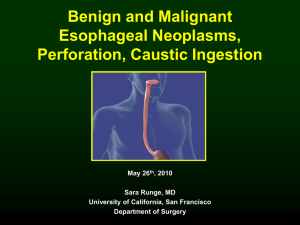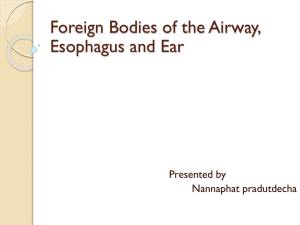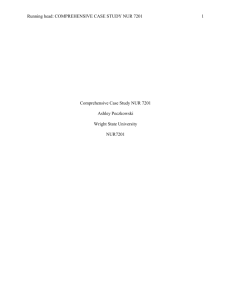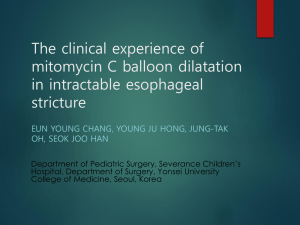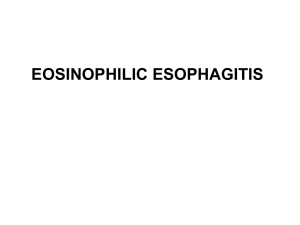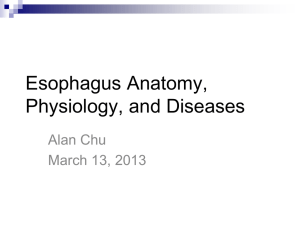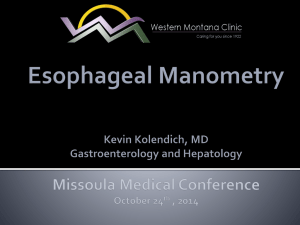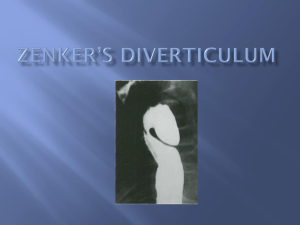Case Conference - Dayton Children`s Hospital
advertisement
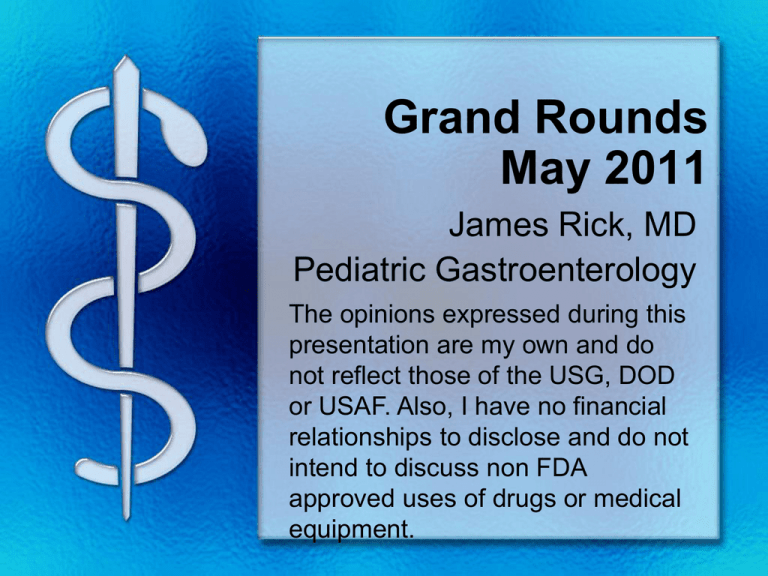
Grand Rounds May 2011 James Rick, MD Pediatric Gastroenterology The opinions expressed during this presentation are my own and do not reflect those of the USG, DOD or USAF. Also, I have no financial relationships to disclose and do not intend to discuss non FDA approved uses of drugs or medical equipment. Now the rest of the story • Admitted to CCHMC 5/25/09 to 5/29/09 – CT with contrast: pneumomediastinum – ENT, GI, PULM, RHEUM – Stopped antibiotics/discharged home • Outpatient procedure 6/3/09 – Nl laryngoscopy and bronchoscopy – EGD: Esophageal and gastric ulcers with air bubbling out esophageal lesion with purulent discharge – BAL showed acute inflammatory exudate Now the rest of the story #2 • Further Diagnosis – Esophagram: • esophageal ulcer right anterolateral aspect 3 cm above LES • Communicated with right infrahilar retrocardiac region • Treatment – NJ feeds, IV PPI, NPO for 14 days, unasyn 14 days – Repeat esophagram 6/25/09, no leak – Advanced to regular diet Follow Up • Chest CT 6/26/09 • EGD/Bronch 7/28/09 – Healing of previous esophageal ulcer – Gastric ulcer, mild gastritis – Negative bronchoalveolar lavage • EGD 11/24/09 – Gastric ulcer, healed esophageal ulcer – Mild distal esophagitis and gastritis • EGD 6/28/10 Objectives • Understand the high morbidity and mortality for esophageal perforation in children and the need for a high index of suspicion to ensure a timely diagnosis • Illustrate the diagnostic approach for the evaluation of esophageal perforation in children Outline • Esophageal Peroration – Etiology of esophageal perforation – Manifestations/Presentation – Diagnosis – Management • Chest Pain – Non-cardiac causes – Pericarditis – Mediastinitis Quick Look at the Objectives • Morbidity and Mortality – Morbidity: roughly 1/3 • Prolonged mechanical ventilation or persistent leak – Mortality: • Wide range: 4 to 44% • Usually from sepsis or multi-organ failure • Increased with delay in dx and tx • Diagnostic Approach – Plain radiographs: may be normal – Contrast esophagography: study of choice with controversary over ideal agent Etiology • Most cases are traumatic or iatrogenic • Spontaneous – Boerhaave syndrome – Triad of emesis, chest pain, and subcutaneous emphysema • Case reports • Review of experience Historical Background • 1723: Herman Boerhaave described barogenic esophageal rupture • 1947: first surgical repair of esophageal perforation • 1952: first esophagectomy after perforation and infant with spontaneous perforation related to esophageal web • 1961: first report in newborn after respiratory suctioning • 1960’s to 1970’s: improved M&M • 1980’s +: change in etiology Etiology: Adult • Adult review published in 2004 (N=559) • Instrumentation (59%) • Spontaneous (15%) • Foreign Body (12%) • Trauma (9%) • Operative Injury (2%) • Other (2%) Ann Thorac Surg 2004;77:1475-1483 Risk With Endoscopy • • • • Flexible: 0.03% Rigid: 0.11% Dilation: 0.09 to 5% Sclerotherapy:1 to 5% Etiology: Children • Children’s Mercy Hospital, Kansas City – 1995 to 2010, retrospective chart review • Etiology (n=8) – Stricture dilation 4 – Foreign Body 2 – NG tube and stricture resection 1 each • 75% of esophageal perforations are iatrogenic • All were managed conservatively Journal of Surgical Research: 164, 13-7, 2010 Etiology: Children • James Whitcomb Riley Hospital, Indiana – 1975 to 1995, retrospective review • Etiology (n=25) – Iatrogenic 17 • Dilation (8), operation (5), NG tube (2), endoscopy(2) – Traumatic 3 • Gun shot wound (2), blunt (1) – Foreign Body – Unknown • No cases of spontaneous Arch Surgery;131,611-618,1996 3 2 Etiology: Children • James Whitcomb Riley Hospital, Indiana – 1975 to 1995, retrospective review • Etiology (n=25) – Iatrogenic 17 • Dilation (8), operation (5), NG tube (2), endoscopy(2) – Traumatic 3 • Gun shot wound (2), blunt (1) – Foreign Body – Unknown 3 2 • No cases of spontaneous Arch Surgery;131,611-618,1996) Etiology: Case Reports • Infectious • • • • • • • – HSV esophagitis – Candida esophagitis – Tuberculosis Eosinophillic esophagitis Pill induced esophagitis Reflux esophagitis/ulceration Barrett esophagus/ulcers Zollinger Ellison Syndrome Behcet’s disease Interesting lack of crohn dz and NSAIDs Clinical Presentation • Spontaneous esophageal perforation – Middle age man – Dietary over indulgence and alcohol consumption – Mackler’s triad: Chest pain, subcutaneous emphysema, and recent vomiting/retching • Will depend on: – Location of perforation – Etiology of the perforation Cervical • Subcutaneous emphysema most common – Found in 90% • • • • • • Spread to mediastinum is slower Dysphagia Dyspnea Neck pain Dysphonia Bloody regurgitation Thoracic • • • • • Rapidly contaminate the mediastinum May spread to pleural cavity as well, L>R Mediastinal and subcutaneous emphysema Involvement of pericardium has been reported Inflammatory response – Chest pain: Retrosternal, can spread to arms, back, and shoulders – Tachycardia, tachypnea, grunting, dyspnea, resp distress – Hypovolumia – Leukocytosis • Systemic sepsis and shock with in hours Abdominal • Uncontained and results in contamination of the peritoneal cavity • Back pain and difficulty lying supine • Epigastric abdominal pain and dysphagia – Maybe referred to the shoulder • Fever, tachycardia, tachypnea, • Rapid deterioration to sepsis and shock Clinical Manifestations: Neonates • History of difficult ET or NG tube placement • Hypersalivation • Coughing/choking/cyanosis with feedings • Pneumothorax • Fever • Bloody drainage from gastric tube Differential Diagnosis • Peptic ulcer with perforation • Acute pancreatitis • Spontaneous pneumothorax and mediastinum • Pneumonia • Aortic aneurysm dissection • Acute myocardial infarction Diagnosis • History of esophageal manipulation or trauma • Otherwise requires high index of suspicion • Initial tests: AP and lateral CXR – May show • Pleural effusion, pneumothorax, subcutaneous emphysema, pneumomediastinum, pneumopericardium, subdiaphargmatic air – May also be normal in 12-33% Contrast Radiography • Establishes diagnosis/localizes injury • Water soluble contrast – Most recommend this first • Limitations • Thin barium (greater density) – Improves sensitivity to 60% in cervical and 90% in thoracic perforations – May cause inflammatory reaction in pleural space • Three injury patterns – Retropharyngeal collection – Contrast tracking parallel and posterior to the esophagus – Free perforation into pleural space Could this be congenital H type TEF? • No – Bronch showed normal trachea – Symptom free till recently – Esophageal and gastric ulcers • Yes: never say never – Case report dx H type in 10 yr girl dx by esophagoscopy and bronchoscopy – Their literature review noted 3 pts over age 10 yrs dx with H type fistula • CLIN PEDIATR February 1996 vol. 35 no. 2 103-104 Diagnosis Computed Tomography • Some institutions use CT with oral contrast as primary modality after plain films • Trend in US is for contrast esophagram • Some advocate use of both in all patients with suspected esophageal perforation Endoscopy • Various recommendations • Pros – May better localize size and location – May aid in diagnosis of cause if unknown • Cons – May worsen injury – Inferior to contrast study Management • Historically based on adult reports – Adult surgeons favored direct surgical repair • Kids esophagi are not little adult esophagi – Adult perfs have more underlying pathology – Kids have increased propensity to heal and often difficult to localize leak • Case series in 1988 (N=12) – All patients treated conservatively – All but 1 healed without need of surgery J of Thoracic Cardiovasc Surgery 1998:95:692 Management: Conservative • Basic Tenant: promote spontaneous healing – Minimize proximal flow, prevent contamination, maintain downstream flow, support nutrition • Broad spectrum antibiotics for 7-14 days – Cultures usually grow polymicrobial organisms • NPO and gastric drainage • Nutrition – TPN if unable to secure enteral access – Enteral • Tube placement: endoscopy, fluoroscopy, place tube in perforation • Resuming oral feeds – When repeat esophagram shows no leak – Average time to esophagram 7 day, restarting feeds 11 days • Thoracostomy tube Management: Conservative Works Best If: • • • • Perforation is instrumental Perforation is cervical in location Perforation is detected early (<24hrs) Perforation is well contained Back to the Case • Esophageal perforation, etiology unknown led to mediastinitis – Suspect reflux related – Possibly iatrogenic or spontaneous • Previous pericarditis – Could this have been related to esophageal perforation and esophagopericardial fistula? Esophagopericardial fistula • Case review (n=49) AJR 141:171-173;July 1983 • Etiology – #1 etiology was esophagitis/esophageal ulcer (75%). Many of these patients had previous reflux or hiatal hernia surgery • Radiographs – Pneumopericardium in 50% – Pneumomediastinum in 17% • Recent case report in a 1yr old Chest Pain • Chief complaint: chest pain • Peds cardiology referral 2nd to murmur • Musculoskeletal most common – 15-30% prevalence • Non-cardiac 98% of the time • More likely cardiac if – Increases with exertion, s/s myocardial ischemia and abnormal cardiac exam – Pediatr. Rev. 2010;31;e1-e9 Chest Pain: Gastrointestinal • Gastrointestinal 8% of the time – GERD and PUD • epigastric, burning, regurg, related to eating, respond to acid blockade – Esophageal spasm or inflammation – Atypical • cholecystitis • esophageal foreign body, strictures, ingestions Chest Pain: Pericarditis • With or without effusion • Usually infectious in nature • Character – Sharp, retrosternal, radiates to left shoulder • Worse with supine position and inspiration • Improves with bending forward Chest Pain: Mediastinitis • Character – Severe and substernal • Worse with inspiration and coughing • Radiates to neck or interscapular area Summary • Esophageal perforation is rare in children and most commonly iatrogenic • Mediastinits/pneumomediastinum • Diagnosis is based on contrast esophagram with +/- CT and endoscopy • Early diagnosis and treatment helps limit morbidity and mortality • Trend toward conservative treatment
